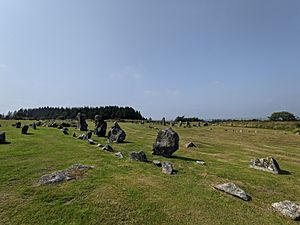Beaghmore facts for kids
Beaghmore is a really old and interesting place in Northern Ireland. It's found about 8.5 miles northwest of Cookstown, County Tyrone. This special site is on the edge of the Sperrin Mountains.
It's a complex of ancient structures from the early Bronze Age. You can find stone circles, stone rows, and cairns here. A cairn is a pile of stones, often built as a monument or burial site.
The name Beaghmore comes from the Irish words an Bheitheach Mhór. This means "big place of birch trees." This name tells us that long ago, this area was a forest. Early farmers from the Neolithic period cleared the trees to make space for their farms.
Today, the Beaghmore stone circles, stone rows, and cairns are protected as historic monuments. They are located in the area of H684 842 on the map.

How Was Beaghmore Found?
This amazing site was discovered by George Barnett. This happened in the late 1930s. Workers were cutting peat (a type of soil made from decayed plants) when they found 1,269 stones!
Archaeologists then started digging. They first excavated the site between 1945 and 1949. It was then taken care of by the state. More digging happened in 1965.
During these digs, they found old fireplaces and tools made of flint. Scientists used carbon dating to find out how old these items were. They date back to about 2900-2600 BC. That's a very long time ago!
Some of the stone rows actually run over the remains of old farm walls. These walls also date from the Neolithic period. This shows that people lived and farmed here before the stones were put up.
In one of the cairns, they found a special polished axe. This axe was made from a stone called porcellanite. It might have come from a place called Tievebulliagh. This axe factory was about 70 miles away in County Antrim. The biggest cairn had a pit in its center. Inside this pit, archaeologists found an oak branch.
What Can You See at Beaghmore?
Beaghmore has many interesting features. There are seven low stone circles. They are all different sizes. Six of these circles are in pairs.
You can also see twelve cairns and ten stone rows. The stone circles are between 10 and 20 meters wide. They are connected to older burial cairns. Some stone rows lead towards the circles.
The stones themselves are quite small. Most are less than 0.5 meters (about 1.5 feet) tall. The circles are not perfectly round. This suggests they might be like the stone borders around some ancient tombs.
A cool thing about the stone rows is how they are arranged. You'll see short rows of tall stones next to much longer rows of small stones. These stone rows spread out from the circles. They generally point towards the northeast.
Digging at the site showed that the stones were built on top of an older farming area. Experts think the stones might have been put up for a special reason. Perhaps the soil was getting bad for farming. Or maybe peat was starting to grow over the land.
See also



